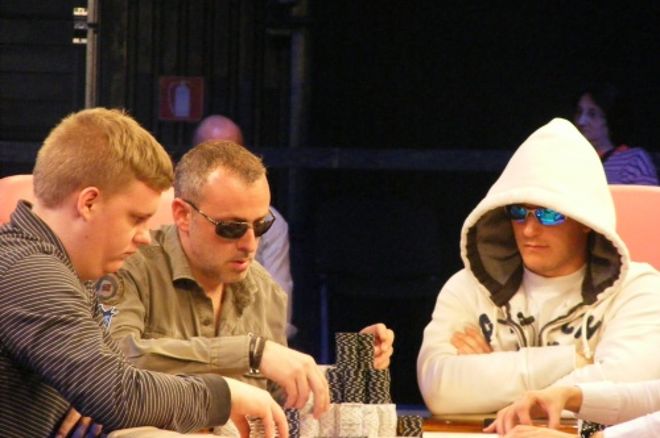

There's a superb opportunity you've never heard of Robert Trivers. I hadn't either until recently. But he's crucial figure within the field of evolutionary biology, particularly in understanding the evolution of social behaviors within and between animal species.
One of his key insights has to do with deception. It had long been recognized that deception is usual in virtually all types of animal communication. Birds will pretend to bury food in a single place while actually leaving it some place else in the event that they know that other birds are watching them. Many species have a sort of bluff-charge, to scare off rivals or predators without the risk of a real fight.
In fact, one roughly male cuttlefish can actually change its coloration pattern in order that it seems like a feminine. He thus gets taken temporarily into the harem of a dominant male that he couldn't hope to defeat in a battle. Then, when the larger male is distracted, he modifies his color pattern back to its native, and quickly mates with the females.
Trivers's insights about deception — and in particular, self-deception — actually contain an invaluable lesson about bluffing in poker. Read on.
The Best Bluffers Have no idea They're Bluffing
Trivers deduced that the frequency of deceptive communication in a species would produce strong selective pressure for the power to detect deception in others. This, in turn, would trigger one of those evolutionary arms race. Heightened ability to detect deception signifies that deception has to become more convincing so as to succeed — and when it does, that creates selection pressure to become even better at discernment.
For example, a twiglet survives by looking like a part of the branch to a hungry bird. However the birds who're better at seeing during the deception get extra meals and usually tend to survive to breed. Because the birds recuperate at picking off the insects, the insects need to evolve ever more sophisticated camouflage to fool their predators.
But, Trivers realized, what's really interesting is that the evolutionary pressure to become better at deception would work best if the animal is self-deceptive — that is, if its deception is completed unconsciously, in order that there are fewer tell-tale signs of it.
"Self-deception involves the counterintuitive proven fact that the conscious actor is kept at midnight regarding relevant pieces of information," Trivers wrote in a 1991 book chapter discussing his work. "Our interpretation is that others are cueing in at the actions of the conscious actor, in order that keeping it at midnight is also one's first defensive position from others…. Selection for deception may induce self-deception — the simpler to stay undetected — thus inducing a sort of unconsciousness."
This makes perfect sense, not just from the perspective of biology, but because it relates to poker. Give it some thought — one of the best bluffers are people who find themselves not aware that they're bluffing.
Consider the novice player who naively believes his middling two pair is the most productive hand on a board stuffed with possible straights and flushes. The easier player with a straight or a child flush is in a tricky spot. He tries to select up on any sign of weakness, finds none, and mucks. The winner rakes the pot, having no concept that he just induced a fold from a more robust hand.
Ignorance Is Bliss
Another example of this circumstance was used as a central plot element in an incredible 1956 poker-themed episode of the Alfred Hitchcock Presents television show called "Crack of Doom."
The story is of a lawyer, Mason Bridges, who gets in over his head in a high-stakes home poker game. To be able to recoup his losses, he "borrows" $10,000 that a client had left in his practice's office safe. He has no strategy to replace it if he loses, so he's desperate. The sport is five-card stud, with the primary card face down, the opposite four up, one at a time, each followed by a betting round. They're playing it no-limit.
By the tip of the hand, Bridges has three queens showing, and the fourth as his down card, while his opponent has three tens showing, and all indications are that he, too, has quads.
They raise one another until finally Bridges confidently puts his whole ten grand into the center. This finally convinces his opponent that Bridges really does have four queens, and never just the 3 he can see. He shows his hidden fourth ten, and reluctantly folds.
Bridges relaxes and takes one last have a look at his hole card, and discovers, to his horror, that he had misread it — it's actually a jack! Had his opponent called, he would have lost the money, and with it both his career and his freedom.
He admits, as he recounts the tale later, that he would never have had the nerve to bet that much on a bluff. His vision have been blurred by so desperately seeing what he desired to see, and this fact was the one thing that allowed him to project a resounding image of a person sitting on an unbeatable hand.
The Art of Self-Deception
Today's lesson, then, is set bluffing. Of course, it's hard to recommend that you just make yourself unaware that you are bluffing. After all, by definition, you can not consciously make an action unconscious. But you can, and should, deliberately think the thoughts you can when you really had the hand that you are representing. Recall George Costanza's much-quoted line from Seinfeld — "it isn't a lie in case you believe it."
I think most people do the other. While looking forward to an opponent to reply to our bluff bet, our thoughts are along the lines of, "Please fold. Oh, please let me break out with it, just this one time! No, don't call! Fold, already, FOLD, DAMN YOU!"
While you're engaged in such thinking, you need to exert considerable effort to not let those toxic thoughts and emotions be translated into visible tells that your opponent might notice. That is difficult, as it means thinking something and doing the other. The mismatch can leak out as information that betrays you.
You attempt to laugh to sound relaxed, nevertheless it comes across as forced and nervous. You are attempting to relax as though in confidence, but your entire muscles are tensed in a foul imitation of someone holding a winner. You are trying to speak nonchalantly, but your voice comes out unnaturally pinched or choppy.
I'm suggesting instead you tell yourself that you just actually did catch the winning straight or flush that your opponent is anxious about. That is, intentionally induce a gentle type of self-deception — specifically, repeating to yourself the thoughts you may have when you really had the winner:
"Yep, I HAVE it. You'll be mad while you see that I chased that draw and got there. Please call, dude — I'LL use the money. There is not any better feeling than holding the nuts like this. You think that your top pair might be good here, but you're wrong. Go ahead and put your chips in, so I WILL BE ABLE TO show you simply how wrong you're. This pot is mine — all mine."
When you feed yourself a script like this, you do not consciously need to attempt to imitate the illusion and actions of strength. With just a little practice, you'll just allow them to flow naturally out of your thoughts, eliminating the damaging discrepancy between the words running through your panicked mind and your stressed imitation of relaxed body language.
Try this next time the location requires running a bluff. I FEEL you can find that it puts you one step ahead within the arms race of deception and detection that we call poker.
Want to stick atop all of the latest within the poker world? If so, be sure to get PokerNews updates for your social media outlets. Follow us on Twitter and find us on both Facebook and Google+!
PokerNews.com is the world's leading poker website. Among other things, visitors will discover a daily dose of articles with the most recent poker news, live reporting from tournaments, exclusive videos, podcasts and such a lot more.
PokerStars is the biggest online poker room offering the most important amount of poker games and different game variations including Texas Hold'em, Omaha and other popular poker games. By joining PokerStars you'll easily learn all of the poker rules and poker strategy by playing free poker games. Join PokerStars and luxuriate in prime quality online poker.

Read More... [Source: PokerNews]
No comments:
Post a Comment